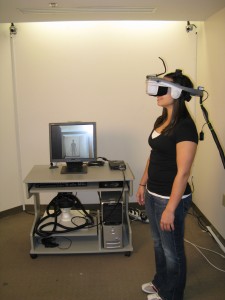Given the recent media attention, I figured it would probably be wise to give a rundown of our experiment recently published in Computers in Human Behavior on the negative consequences of wearing sexualized avatars in a fully immersive virtual environment. Although several media sources are framing this as a study involving video games, there was no gaming element to it (although I expect the findings to apply to video games, there are different variables to consider in those settings).

A fully immersive environment. The user is in a head-mounted display (HMD) and can only see the virtual world, which changes naturally as she moves.
This study was conducted while I was still at Stanford working in the Virtual Human Interaction Lab. I conceived the study as a followup to a previous study whose results had confounded me. In that study (published in Sex Roles), men and women were exposed to stereotypical or nonstereotypical female virtual agents, and we found that stereotypical agents promoted more sexism and rape myth acceptance than nonstereotypical agents. I was surprised because we found no difference between men’s and women’s attitudes. Thus, I wanted to investigate further to see how virtual representations of women affected women in the real world.
In the current experiment, we placed women in either sexualized or nonsexualized avatar bodies. We used participants’ photographs (taken several weeks before for a presumably unrelated study) to build photorealistic representations of themselves in the virtual environment. Thus, when a woman entered the VE, she saw her face or another person’s face attached to a sexualized or nonsexualized avatar body.
In the virtual environment, women performed movements in front of a mirror so that they could observe the virtual body and experience embodiment (i.e., feel like they were really inside of the avatar’s body). They had a brief interaction with a male avatar afterwards and then we measured their state self-objectification (through the Twenty Statements Test, which is simply 20 blanks starting with “I am ______”). Then, we told them they would be participating in a second, unrelated study. They were allowed to pick a number that “randomly” redirected them to an online study. All participants were redirected to “Group C” which was framed as a survey on social attitudes. The rape myth acceptance items were masked in a long survey with other items.
We found that women who embodied a sexualized avatar showed significantly greater self-objectification than women who embodied a nonsexualized avatar. Furthermore, and counter to predictions, women who embodied an avatar that was sexualized and looked like them showed greater rape myth acceptance.
This second finding was puzzling; I thought seeing oneself in a sexualized avatar would make participants more sympathetic. Our best explanation was that perhaps that seeing oneself sexualized triggered a sense of guilt and self-blame that then promoted more acceptance of rape myths.
Since this study I have conducted two other studies (both using nonimmersive environments to make sure that it is not just the high-end technology yielding these results) that support these findings. Feel free to contact me if you’re interested in those papers.
You can find media coverage of this study at the links below:
*Original story by Cynthia McKelvey for Stanford News Service (also posted at PhysOrg)
* Video Games’ Sexual Double Standard May Have Real-World Impact by Yannick LeJacq at NBC News
*How Using Sexualized Avatars in Video Games Changes Women by Eliana Dockterman at Time
*Using a Sexy Video Game Avatar Makes Women Objectify Themselves by Shaunacy Ferro at Popular Science
*The Scientific Connection Between Sexist Video Games and Rape Culture by Joseph Bernstein at Buzzfeed
